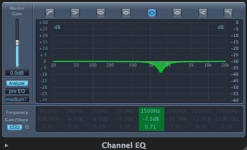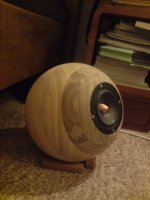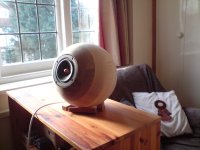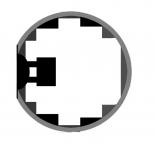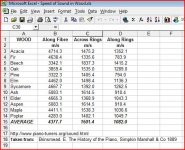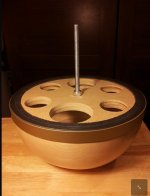Hi, I'm new to this (rather amazing) forum and only recently became interested in designing speakers after stumbling across the various ingenious Ikea bowl designs that people have made. I made a similar speaker from solid ash and black walnut (photos below, not very well taken, and without a proper speaker stand so they don't really do it justice).
Anyway, it sounds really good to my ears (i.e. not dissimilar to my dad's £500 Mission towers, apart from a slight tinniness. However, using my sequencer's EQ to cut by 6db at about 1500Hz removes the tinniness, and vastly improves the sound. Is this likely to be caused by the design of the enclosure?
Would making a basic notch filter, like the designs I've seen elsewhere on this forum get me a similar result without having to play all my music through Logic's EQ? Is there a better way of establishing exactly where this spike is, or should I just continue going by ear? I'm pretty happy with the post-EQ result I currently have.
Would anyone be able to help me establish the values of the components I would need? Do i just solder them together and stick them in front of the negative terminal on the speaker? I'm really struggling to make sense of the information out there. I'll try to upload a screenshot of the EQ curve I'm trying to achieve.
thanks very much - and sorry if these are newbie questions
Anyway, it sounds really good to my ears (i.e. not dissimilar to my dad's £500 Mission towers, apart from a slight tinniness. However, using my sequencer's EQ to cut by 6db at about 1500Hz removes the tinniness, and vastly improves the sound. Is this likely to be caused by the design of the enclosure?
Would making a basic notch filter, like the designs I've seen elsewhere on this forum get me a similar result without having to play all my music through Logic's EQ? Is there a better way of establishing exactly where this spike is, or should I just continue going by ear? I'm pretty happy with the post-EQ result I currently have.
Would anyone be able to help me establish the values of the components I would need? Do i just solder them together and stick them in front of the negative terminal on the speaker? I'm really struggling to make sense of the information out there. I'll try to upload a screenshot of the EQ curve I'm trying to achieve.
thanks very much - and sorry if these are newbie questions
Attachments
Hi. It is a shielded CSS FR125. The inside diameter of the sphere is tricky - in the cross section below the external diameter of the light grey circle is 28cm, and the internal diameter is 26cm -however, I left those internal ridges in the sphere as an attempt to break up the soundwaves and avoid standing wave problems I had heard people saying might be a problem with spheres.
After I had made the speaker, the only way I could think to ascertain the actual volume was by filling it with small bean-bag beans poured out from a litre measuring jug. The internal volume seems to be seven and a bit litres. The speakers don't really sound too boomy in the low end, so I'm assuming that this volume is OK for these drivers.
Thanks for replying
After I had made the speaker, the only way I could think to ascertain the actual volume was by filling it with small bean-bag beans poured out from a litre measuring jug. The internal volume seems to be seven and a bit litres. The speakers don't really sound too boomy in the low end, so I'm assuming that this volume is OK for these drivers.
Thanks for replying
Attachments
-however, I left those internal ridges in the sphere as an attempt to break up the soundwaves and avoid standing wave problems I had heard people saying might be a problem with spheres.
I find this to be counter-intuitive. I have no idea about standing-wave theory, but I would have assumed the flat surfaces would make the issue worse, not better. I could be completely wrong, though.
Hi. It is a shielded CSS FR125. The inside diameter of the sphere is tricky - in the cross section below the external diameter of the light grey circle is 28cm, and the internal diameter is 26cm -however, I left those internal ridges in the sphere as an attempt to break up the soundwaves and avoid standing wave problems I had heard people saying might be a problem with spheres.
7 litres is a good volume for FR125
A sphere will usually have a single resonce related to the diameter and can be ameriolated by putting a good wad of damping at the centre. By squaring things off you have distributed them a bit, but it is most likey still the problem. The dimensions are very close to the frequency you ar ehacing to cut. I would start by suspending a dense bit of damping in the centre and at the walls, with less dense fluff in between.
You might want to drill an array of small holes in the back & damp them aperiodically. Similar to below. It will decrease pressure in the box that is supporting the resonance.
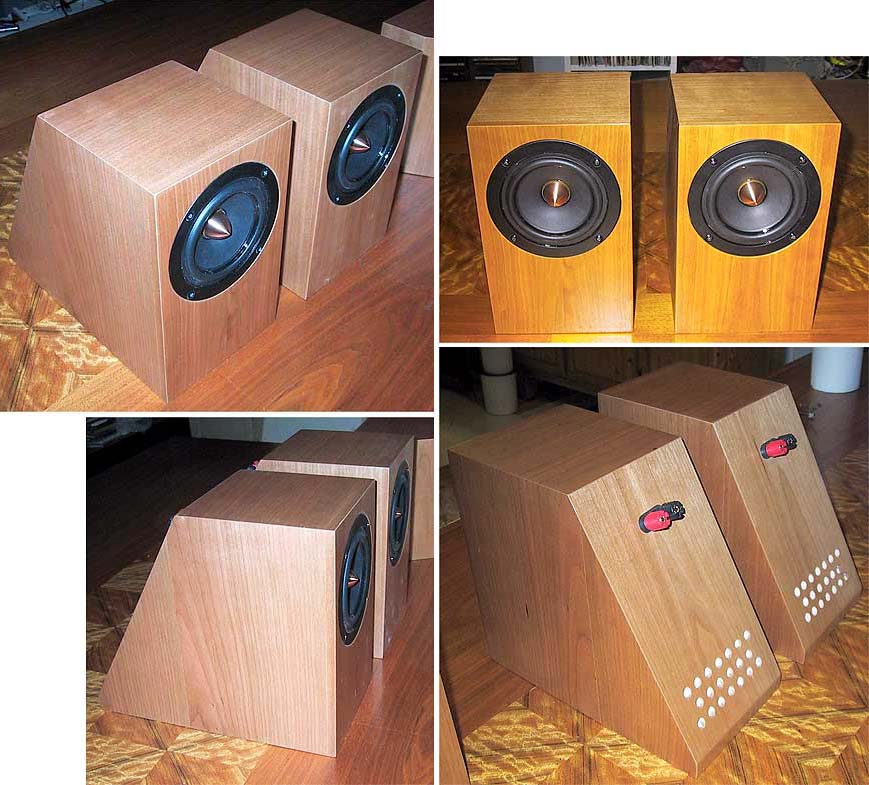
dave
yes, you have to address the single (big) standing wave inside the enclosure.
And there is baffle step.
Notice the smooth roll-off of the sphere (like yours, but yours is smaller ?)
True Audio TechTopics: Diffraction Loss
and also fletcher munson curve (why a smily face sounds good to our ears on a 10-band eq).
Fletcher-Munson Curve Explanation
Fletcher?Munson curves - Wikipedia, the free encyclopedia
Just some food for thought.
Norman
And there is baffle step.
Notice the smooth roll-off of the sphere (like yours, but yours is smaller ?)
True Audio TechTopics: Diffraction Loss
and also fletcher munson curve (why a smily face sounds good to our ears on a 10-band eq).
Fletcher-Munson Curve Explanation
Fletcher?Munson curves - Wikipedia, the free encyclopedia
Just some food for thought.
Norman
Dave - I've tried drilling holes in the back and damping them, but it seems to make little or no difference. I've also tried damping with lambswool, with a dense wad tied around the y-shaped brace in the centre of the sphere (sorry, forgot to mention this bracing wasn't on my cross-section) and more teased out wool elsewhere. Even if I radically overstuff the enclosure to the point that the music sounds dead, there's still quite a strong nasal-sounding resonance.
I had hoped that the brace running through the centre would be enough to avoid standing wave problems, but seemingly not. Perhaps instead of this 3-pronged propellor shaped brace, I should have left a wall between the two halves of the sphere, then drilled lots of different sized holes in it with a hole-saw?
Norman - Thanks for the link, but I found it swiftly lost me when it got more technical. Is it suggesting that to make up for the bass that is lost behind the cabinet (due to being less directional than higher frequencies), that the mids and highs should be cut using a passive circuit, until they are brought down to a compensatory level? How would I go about designing such a circuit? Would it be similar to the notch filter idea, just set much, much broader?
I'm assuming that getting rid of the standing wave internally will give a better result than trying to EQ away the problem?
I had hoped that the brace running through the centre would be enough to avoid standing wave problems, but seemingly not. Perhaps instead of this 3-pronged propellor shaped brace, I should have left a wall between the two halves of the sphere, then drilled lots of different sized holes in it with a hole-saw?
Norman - Thanks for the link, but I found it swiftly lost me when it got more technical. Is it suggesting that to make up for the bass that is lost behind the cabinet (due to being less directional than higher frequencies), that the mids and highs should be cut using a passive circuit, until they are brought down to a compensatory level? How would I go about designing such a circuit? Would it be similar to the notch filter idea, just set much, much broader?
I'm assuming that getting rid of the standing wave internally will give a better result than trying to EQ away the problem?
Even if I radically overstuff the enclosure to the point that the music sounds dead, there's still quite a strong nasal-sounding resonance.
The driver cut-out is well champered on the back-side?
dave
Dave - it wasn't, but it is now, and doesn't seem to have made much difference, if any. There's still quite a nasal peak.
Norman - thanks, at least the speaker looks good - and hopefully if I keep working at it, it will sound good, too
I used my sequencer to approximate the EQ curves suggested on that page, and the speaker sounded much better balanced, less bright and more bass, a much more natural sound. I'll definitely look into compensating for the baffle loss, but it's a struggle getting my head round the technicalities of that article. Are you saying that the circuit design given there won't be compatible with my full-range speaker?
Norman - thanks, at least the speaker looks good - and hopefully if I keep working at it, it will sound good, too
I used my sequencer to approximate the EQ curves suggested on that page, and the speaker sounded much better balanced, less bright and more bass, a much more natural sound. I'll definitely look into compensating for the baffle loss, but it's a struggle getting my head round the technicalities of that article. Are you saying that the circuit design given there won't be compatible with my full-range speaker?
is this calculator any good? the circuit looks simpler, and the site tells you the component values.
Loudspeaker Diffraction Loss and Baffle Step Compensation Circuits
Loudspeaker Diffraction Loss and Baffle Step Compensation Circuits
it's an NAD C320 BEE, but the drivers sounded fine in an open baffle made from mdf, so I would have thought that it is some design flaw with the cabinet. I haven't really got another amp to test it with. It's frustrating, because after EQing, the speaker sounds really good to me.
I would have thought the central brace would disrupt any standing waves going through the middle of the cabinet, but maybe those parallel rings on either side (as in the cross section) are sustaining some sort of standing wave between them? Though if that's the case, shouldn't the stuffing have dealt with it?
Going back to my first post, is designing a notch filter the wrong way to deal with the problem?
I would have thought the central brace would disrupt any standing waves going through the middle of the cabinet, but maybe those parallel rings on either side (as in the cross section) are sustaining some sort of standing wave between them? Though if that's the case, shouldn't the stuffing have dealt with it?
Going back to my first post, is designing a notch filter the wrong way to deal with the problem?
First things first; calculate the wavelength of the frequency (keep in mind that your altitude above sea level will affect this dimension, if it is of any magnitude).
Once you know the wavelength (in cm or inches) it is a simple matter to locate where the resonance originates (keep in mind there may be more than 1 locus).
Once you know the wavelength (in cm or inches) it is a simple matter to locate where the resonance originates (keep in mind there may be more than 1 locus).
I am a total novice in speakers but since this topic resembles my quest to suppress vibration in the plastic case, I took a liberty to do some calculations. They maybe irrelevant, not applicable or just plain wrong, but the end result is quite striking.
These speakers are made of wood laminate which looks pretty solid. I presumed that it is the solid wood with some kind of surface wave propagating across the grains (just looking at the pictures). As the properties of actual material are unknown to me, I took an average speed of sound for different sorts of wood. (See my compilation attached as a picture).
The sphere made of this hypothetical ‘average’ wood with the external diameter of .28m (from the author’s post) will have the fundamental frequency of standing surface acoustic wave between 1230Hz (along rings) and 1706Hz (across rings). In presumption that ratio is 50-50, the average (once again!) gives us the frequency of 1468Hz.
Pretty damn close to the troublesome resonance frequency!
These speakers are made of wood laminate which looks pretty solid. I presumed that it is the solid wood with some kind of surface wave propagating across the grains (just looking at the pictures). As the properties of actual material are unknown to me, I took an average speed of sound for different sorts of wood. (See my compilation attached as a picture).
The sphere made of this hypothetical ‘average’ wood with the external diameter of .28m (from the author’s post) will have the fundamental frequency of standing surface acoustic wave between 1230Hz (along rings) and 1706Hz (across rings). In presumption that ratio is 50-50, the average (once again!) gives us the frequency of 1468Hz.
Pretty damn close to the troublesome resonance frequency!
Attachments
Now i'm running out of suggestions... nasal, cupped is usually a reflection coming back thru the cone...
dave
That would be my guess too. I doubt the steps on the interior surface are large enough to effectively spread the primary resonance. Any central obstruction to spread the resonance will have to be comparable in size to the wavelength of the problem frequency, around 9", so that's going to be impractical. Any smaller and the wave will just diffract round it, just like what happens on the outside.
Killing the resonance defined by the sphere is tricky and we tend to overlook that the driver cone is practically transparent at all but the highest frequencies.
Try removing the driver, then stick your head close to the driver cutout and use your vocal chords to "sweep" the enclosure, you'll hear the enclosure "come back" at you, and if that cuppiness you hear with the driver in place is still there: you have your culprit. You'll look a complete idiot but it will give you an idea of what contribution that one big resonance is making.
B&W intersect a tube with the sphere to suppress it:
http://www.bowers-wilkins.co.uk/Sphere-Tube.html
French Manufacturer Elipson use an internal Helmholtz resonator to tackle the problem:
http://www.elipson.com 4260BN.pdf
I've heard the Elipson's, and the idea works well IMO.
Last edited:
Divad - well, if the spike is around 1500Hz, that would give a wavelength of 23 cm, not far off the internal diameter of the sphere. This certainly seems a likely explanation for the problem, but many other people online have made Ikea bowl speakers (of almost exactly the same dimensions as mine) and I haven't noticed this problem reported anywhere. Also, I'm not sure what to do about it if this is the cause - although the picture I've attached below shows a piece of mdf that the author of this thread ( http://www.diyaudio.com/forums/markaudio/197798-ikea-bowl-speaker-chr-70-gen-3-a.html ) placed in the centre of his sphere to deal with standing waves. Does it look suitable?
r6578 - that's an interesting idea, are you suggesting that the wood itself naturally resonates at this frequency? Or that a surface wave is being created around the insides of the sphere because I left the solid wood unfinished? Elsewhere on this site (including two pictures in this thread: http://www.diyaudio.com/forums/markaudio/197798-ikea-bowl-speaker-chr-70-gen-3-a-3.html ) people have built solid wood spherical speakers of a similar size. The fact that many other people have managed to successfully build spherical designs in solid wood means that I don't want to give up on this idea - also, they look beautiful
I can't find much on surface acoustic waves online that seems to be relevant to audio. If SAWs are the problem, have you any suggestions for reducing this wave?
Simon - looking a complete idiot is really not a problem with me The enclosure seems to resonate when I sing an F sharp 3 (i.e. the one below middle C) into the driver hole. An online table says this is 185 Hz, quite a way off the problem I'm having in the upper mids. Interestingly, the table I looked at (Frequencies of Musical Notes) does suggest that the problem frequency is another F Sharp - only one three octaves higher - and this note (F sharp 6) has a wavelength similar to the sphere's internal diameter. Is this a coincidence? it's only around the F sharp 3 that the enclosure resonated to my voice, not any higher, as far as I could tell.
The enclosure seems to resonate when I sing an F sharp 3 (i.e. the one below middle C) into the driver hole. An online table says this is 185 Hz, quite a way off the problem I'm having in the upper mids. Interestingly, the table I looked at (Frequencies of Musical Notes) does suggest that the problem frequency is another F Sharp - only one three octaves higher - and this note (F sharp 6) has a wavelength similar to the sphere's internal diameter. Is this a coincidence? it's only around the F sharp 3 that the enclosure resonated to my voice, not any higher, as far as I could tell.
B&W's solution is interesting, but not really possible for me to build, these were difficult enough.
I'm not sure replicating the Helmholtz resonator from Elipson's £19,000 speakers is that practical either, unless you have any ideas? Is it complicated, or could I just put a smaller wooden sphere with a couple of holes in it inside the main enclosure? I'm new to speaker design so this all quite complicated - isn't a helmholtz resonator sort of like a bass port? Don't they amplify the chosen frequency?
It's interesting you've heard them - how good do £19,000 speakers sound? Don't think I've ever heard anything over £600
r6578 - that's an interesting idea, are you suggesting that the wood itself naturally resonates at this frequency? Or that a surface wave is being created around the insides of the sphere because I left the solid wood unfinished? Elsewhere on this site (including two pictures in this thread: http://www.diyaudio.com/forums/markaudio/197798-ikea-bowl-speaker-chr-70-gen-3-a-3.html ) people have built solid wood spherical speakers of a similar size. The fact that many other people have managed to successfully build spherical designs in solid wood means that I don't want to give up on this idea - also, they look beautiful
I can't find much on surface acoustic waves online that seems to be relevant to audio. If SAWs are the problem, have you any suggestions for reducing this wave?
Simon - looking a complete idiot is really not a problem with me
B&W's solution is interesting, but not really possible for me to build, these were difficult enough.
I'm not sure replicating the Helmholtz resonator from Elipson's £19,000 speakers is that practical either, unless you have any ideas? Is it complicated, or could I just put a smaller wooden sphere with a couple of holes in it inside the main enclosure? I'm new to speaker design so this all quite complicated - isn't a helmholtz resonator sort of like a bass port? Don't they amplify the chosen frequency?
It's interesting you've heard them - how good do £19,000 speakers sound? Don't think I've ever heard anything over £600
- Status
- This old topic is closed. If you want to reopen this topic, contact a moderator using the "Report Post" button.
- Home
- Loudspeakers
- Full Range
- Spherical speaker design help needed
